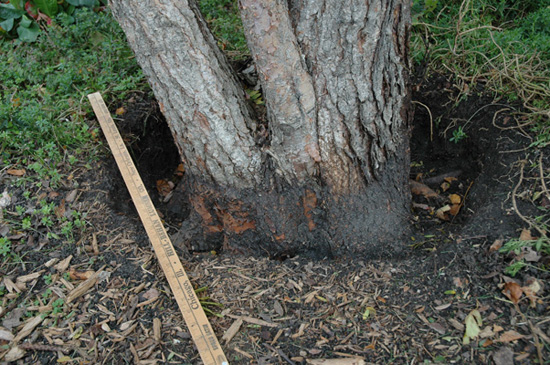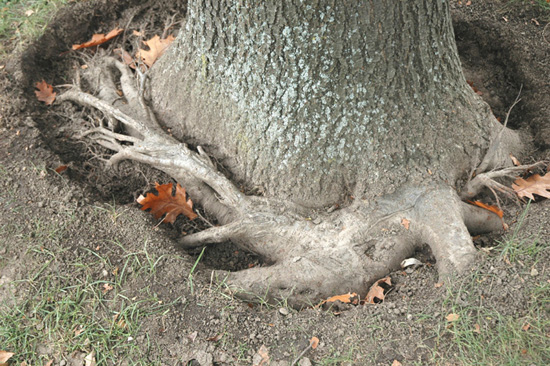Issue 6, May 29, 2009
Deep Planting and Girdling Roots
Deep planting and girdling roots are problems that were initiated about 30 years ago but are affecting trees (and shrubs) now. Both conditions may kill trees and shrubs and are often misdiagnosed.
One issue is deep planting. When a tree or shrub is planted too deeply, the lower stem is placed below the soil and gaseous exchanges cannot occur freely through the bark. This condition does not immediately kill the plant. Decline may occur for many years before the plant passes the point of no return. Once the bark begins to fall from the trunk, the end is near. A similar slow decline may occur when mulch is mounded around the base of a tree.

Deep planting is not difficult to avoid. Locate the first major root coming off the trunk and place it just below the soil line. You may need to remove some of the top of the root ball to do this. A flare of the trunk should be visible above the soil line. The trunk should not be the same width at the soil line as it is 4' up the trunk. It is really a pretty simple concept: roots are below ground and everything else is above the ground. The image shows a birch tree that has been planted too deeply. The yard stick indicates the soil line. The darker colored bark was covered by soil. We dug 8" before we found a major root and the beginning of root flare. The tree is alive but has struggled over the last 20 years. The situation is complicated by clay soil with high pH, resulting in chlorosis. For many years the entire situation was blamed on the soil. Deep planting is probably half of the problem.
Many of the deciduous tree samples we receive at the Plant Clinic show scorching, wind tatter, and perhaps cold injury. Often these same trees exhibit poor stem growth for at least the last 3-5 years. Follow-up questioning and photographs of the lower trunk frequently show that the tree was planted too deeply. Deep planting can cause slow decline of a tree over many years. It may not kill the tree but will not allow the tree to thrive. Does a tree that is planted too deeply need to be removed? That is not usually the case, but there are things that can be done by arborists to help the tree grow better. Deep planting is a major problem in our landscapes and one that is completely avoidable.
The second issue is girdling roots. If major roots grow in a circle around the trunk, they will eventually strangle the trunk. It may take years for this to happen. The trunk grows in girth but so do the encircling roots. By the time the tree dies, the installer is long gone. We are left to deal with the problem.

Girdling roots may be more difficult to detect. Sometimes they cause the same lack of flare caused by deep planting. Other times, trunk flare is present, but growth is stunted, resulting in small, off-color leaves, and possibly stem dieback. The picture in this article shows the base of a red oak tree with the collar exposed. The trunk has a nice flare, but a major girdling root has been growing for 25 years. It often takes that long for roots growing around the tree to become girdling. The message to remember is to make certain that you are planting trees correctly. You would be surprised at how many so called "diseased trees" are actually those stressed by deep planting and girdling roots.
The International Society of Arboriculture (ISA) created www.treesaregood.com to provide quality information on tree care to the public. A section on planting new trees explains the planting process and has a helpful diagram to illustrate major points. Taking the time to plant your tree correctly will help ensure a healthy tree for many years to come. Deep planting will only cause years of tree decline and frustration in tree care.--Nancy Pataky
Author:
Nancy Pataky